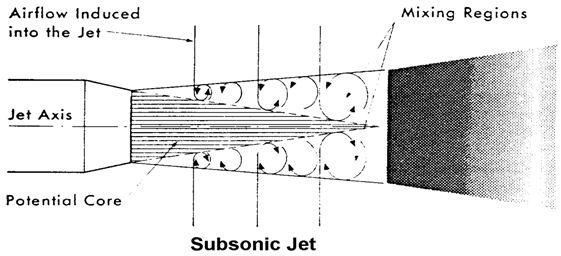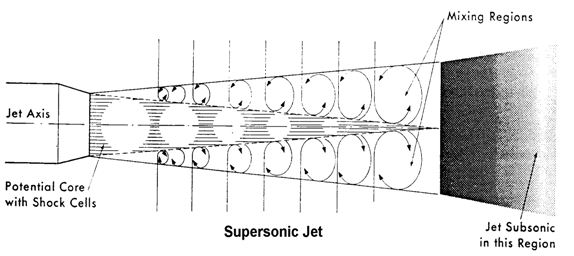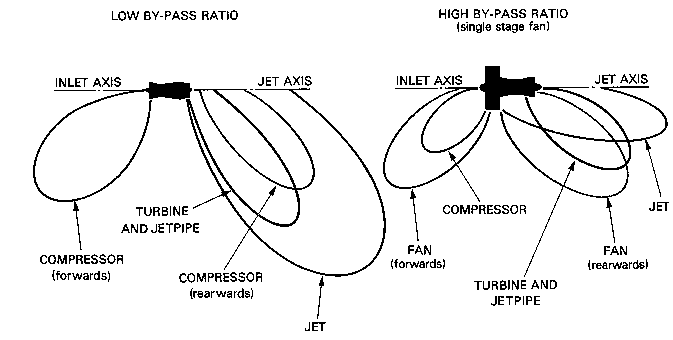sources of engine noise
To understand the problem of engine noise suppression, it is necessary to have a working knowledge of the noise sources and their relative importance. The noise from the jet engine mainly originates from three sources:
a) Exhaust jet
b) Turbine
c) Compressor and/or front fan.
Exhaust Jet
Jet noise is an externally generated source, which radiates in a rearward direction. It is caused by the mixing process of the high-speed exhaust gases with the surrounding air. In the mixing regions, a severe gradient of velocity exists normal to the jet and due to the viscosity of the air, this gradient produces vortices and shear forces which, in turn, produce quadrupole noise sources.


The noise produced by such a source will be proportional to p2Vje8, where p is the air density and Vje is the jet efflux velocity.
Turbine Noise
Noise from the turbine is made up from two sources:

a. White Noise. "White", random or background noise is caused by the reaction of each blade to the passage of air over its surface. There will always be noise from eddy shedding in the blade wake reacting back on the blade and causing random fluctuations over the blade surface (this source of noise may be likened to that produced by opening the quarter-light window on a car). Random noise will also be caused by turbulence in the air stream, which is sensed by the blade as a change in incidence with corresponding lift fluctuations and hence noise.
b. Discrete Noise. Discrete noise is produced by the regular passage of rotating blades through the wakes from the preceding stationary vanes. If the space between vanes and blades is small, there is a cyclic interaction between pressure field. This can be overcome to some extent by design, ie. increasing the space. An additional source of discrete tones is caused by the rotating stage sensing changes of incidence and hence lift pressure, passing through the wakes of the upstream vanes.
Compressor and Fan Noise
Compressor noise whilst significant, was relatively small compared with the exhaust noise generated by turbojet and low by-pass engines. However as fans have got larger and by-pass ratios have increased the noise generated by the fan and compressor may well exceed that produced by the exhaust.
Resultant Engine Noise
Noise from an engine is the combination of noises produced by the compressor, the turbine and the nozzle. With the low by-pass engine, the exhaust noise level drops as the velocity of the exhaust gases is reduced and the turbine noise level drops as LP turbine mass flows and velocities are relatively reduced; but LP compressor noise becomes significant over a wider range of thrust. As the by-pass ratio is increased, the exhaust jet and turbine noise levels continue to drop and the LP compressor (fan) noise level continues to rise. This trend continues until the exhaust jet noise level is less than the turbine noise level and the fan noise reaches a level comparable with exhaust jet of a pure jet engine. There will be no such increase in the fan noise if a single-stage fan without IGV's is aerodynamically suitable; instead, a significant decrease to a level comparable to the turbine noise will occur, as illustrated in the figure. This is because the more powerful elements of discrete tone and background noise are obviated.